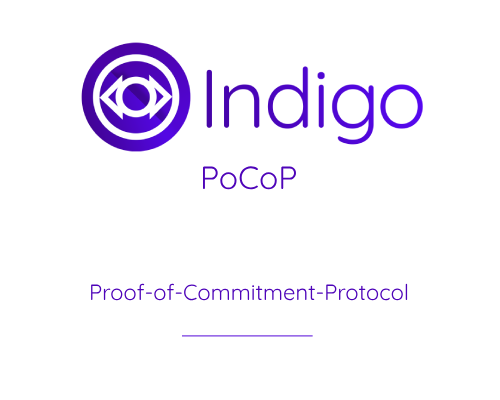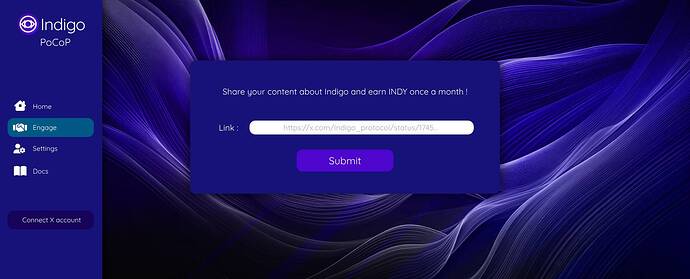
1. Introduction
PoCoP (acronym for Proof-of-Commitment-Protocol) is an innovative way of remunerating users for their direct or indirect contribution to the promotion of indigo Protocol. The Cardano blockchain is an ecosystem of enthusiasts guided by a committed community. We think it’s an interesting idea to be able to thank the community for its efforts and commitments. The members of the POG have therefore been looking for an innovative and decentralised way to allow everyone to participate freely and without constraints in the efforts that contribute to the knowledge of the protocol. We came up with the original idea of PoCoP on the Ergo blockhain and in particular Ergone, which already uses this mechanism that we try to adapt to our needs.
The idea would be to allocate a certain amount of INDY tokens each month to content creators, whether they be tweets, videos, educational content or other original proposals. Content creators log on to the Indigo PoCoP portal and submit their content. Moderators check that the content is not spam or duplicate, and that it meets minimum quality requirements.
At the end of each month, content creators will have access, via the Indigo interface, to additional rewards for helping to democratise the protocol.
To encourage perseverance, a notion of karma will enable content creators to accumulate more rewards month after month.
2. Action plan
We want to launch a 4-month POCOP season during which 500 INDYs will be distributed per month, with a limit of 100 INDYs per person.
The moderators will rank the content on a scale of 1 to 10, and a hardcap based on the score will be applied to the payment for the content. Level 5 content will be worth 5 times more than level 1 content.
The moderators will initially be members of the POG, and then we will re-evaluate if necessary. They will assign a score to the content, then an average will be calculated and the score will be rounded up.
Hard cap for content according to its rating:
1 : 1 INDY max (content with very limited added value, price prediction, etc.)
2 : 3 indy max
3: 6 indy max
4: 8 indy max
5 : 10 indy max
6 : 15 indy max
7 : 20 indy max
8 : 30 indy max
9 : 50 indy max
10 : 100 indy max
On this basis, each creator obtains a sum of scores that will be used to define the share of income to which he or she is entitled.
We defined a maximum amount that a user can receive. The hardcap is used to limit the rewards if there are few entries. If there is a lot of participation, the rewards are shared equally, with content rated 10 counting 10 times more than content rated 1.
Karma: To encourage continued or at least recurring participation:
Each user gets a percentage bonus equivalent to their best rating for the month. In this way, the best possible bonus is 10% for a user who has created a very-high-quality pieces of content.
This percentage accumulates month after month.
3. Access to PoCoP
We want to add a link to PoCoP to the existing user interface (see Figure 1).
This new website ( see Figure 2) would act as a link between the X, YouTube etc. accounts, and allow users to connect a portfolio to retrieve the information needed to pay content creators.
Via this PoCoP portal, each user will be able to post the content they have created, alerting the community to the work they have done, and allowing moderation to take over.
Moderators will be able to consult the various ‘proofs of commitment’ of each creator and rate them from 0 to 10.
We would like to add a rewards line in the “Portfolio & Rewards” section of the interface, where users will be able to collect their looks every month or every 6 epochs.
Fig 1:
Fig 2 :
4. Limits and developments
To avoid getting bot and creating accounts for the sole purpose of collecting rewards, each Twitter account must have a minimum of 100 followers, whereas other platforms require 50 subscribers.
It’s possible that after each month, the reward calculations will be made public before being distributed, so that the community can double-check the moderators’ work.
The aim of this project is to make Indigo shine by rewarding active members of the community.
5. Transparency and ethics
The moderators will initially be members of the POG and, as they are already paid, there is no need for them to be paid.
Also, in the interests of transparency, we will display on the web interface a list of the wallets that have been remunerated by the PoCoP and the quantity of tokens received.
This concept has already been discussed here : Indigo PoCoP - Proof-of-Commitment-Protocol
This version 2 has been designed as a simple, effective prototype to test the idea. Depending on the reaction of the community, it may not last, or it may be improved to better serve the interests of the DAO.
Thanks for reading, sharing and discussing.

